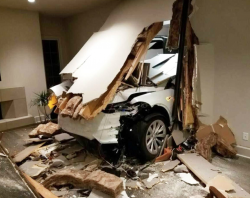
— A Tesla sudden unintended acceleration lawsuit won't receive class-action certification as a federal judge ruled the case can move forward based only on the claims of one individual.
That plaintiff, Ji Chang Son, originally filed the lawsuit in 2016 after claiming his Tesla Model X suddenly accelerated on its own and sent the SUV through the interior wall of his garage.
According to Son, a South Korean celebrity who lives in California, he was heading home with his son when he slowed to about 6 mph to pull into the driveway and into the garage. The plaintiff claims the Model X accelerated at full throttle and destroyed everything in its path, finally coming to a stop inside the living room.
Tesla filed a motion to dismiss the sudden unintended acceleration lawsuit in June 2017 by telling the judge the claims of owners were "fatally defective."
Tesla told the judge data from the SUV showed the Model X accelerator pedal was pushed to the floor when the vehicle accelerated through the wall.
The automaker also told the judge that owners are pretty much living in fairytale land by saying the vehicles shouldn't crash into any objects even if drivers are flooring the accelerator pedals. According to Tesla, those owners want something no automaker offers: a failsafe vehicle.
Mr. Son and other owners claim Tesla markets the Model S and Model X as equipped with automatic emergency braking to stop the vehicles even if drivers aren't paying attention to objects in the path of the vehicles.
According to the lawsuit, Tesla programmed the vehicles to deactivate the feature if the accelerator pedal is pressed to the floorboards. But Tesla said owner's manuals for the vehicles warn drivers not to rely on automatic emergency braking to prevent collisions.
"Automatic Emergency Braking is not designed to prevent a collision. At best, it can minimize the impact of a frontal collision by attempting to reduce your driving speed. Depending on Automatic Emergency Braking to avoid a collision can result in serious injury or death."
The plaintiffs also argued Tesla falsely advertised the vehicles, but the automaker told the judge the plaintiffs can't prove they ever saw or heard any advertisements.
In response to the 2017 motion to dismiss, the judge dismissed certain claims but allowed breach of warranty claims to proceed.
In denying class certification, the judge ruled that by November 23, 2018, plaintiffs Ghodrat Khansari, Madhusudhana Shastrula, Ali Jarrahi, Michael Tomko, Kenneth Helman and Bridgette Waldemar "shall dismiss their claims with prejudice as to each Plaintiffs’ individual claims and without prejudice as to the claims of the purported class."
This leaves only original plaintiff Ji Chang Son who has until December 13, 2018, to "file a consent motion or stipulation for leave to file an amended complaint, which shall include individual claims only and no claims on behalf of any class."
Tesla will then have 30 days after approval of the motion or stipulation to file a response to the amended lawsuit.
The judge set a case management conference for January 14, 2019.




